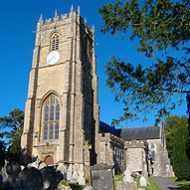The church may owe its name to St Wite…
Photo Credit: Kay Wilkinson
The Origins of St Candida and Holy Cross
The present building was started during the reign of William the Conqueror although the first mention of a church was in 881AD, when Alfred the Great bequeathed Hwitancircian (Whitechurch) to his youngest son. It was much enlarged in 1190 when the church and benefice was granted to the Bishop of Sarum.
In 1240 the Bishops of Sarum and Wells required more funds and so decreed that the benefice of Whitchurch, one of the largest parishes in England, pay its tithes directly to them. A vicar was then appointed instead of a rector. The word Canonicorum (of the canons) was added to Whitchurch.
The church may owe its name to Saint Wite (Candida being the Latin form of white) or to the light coloured stone of which it is built.
Centre of Pilgrimage
Apart from Westminster Abbey it is the only church with a surviving Medieval shrine containing the intact relics of its Saint. During the Middle Ages it was a major centre of pilgrimage and is still often referred to as ‘the Cathedral of the Vale’.




Photo Credits: Sue Holmes, Sara Hudston
The Building
St Candida and Holy Cross Church is a Grade 1 listed building. The font, south aisle and arcade are all Norman.





Photo Credits: Sue Holmes, Sara Hudston
When the church was enlarged in the 13th century, the north and south transepts were added, the chancel lengthened and the chancel arch rebuilt. The barrel roofs of the nave and north transept are original, dating from 1400 and at this time, the tower and porch were added.






Photo Credit: Sara Hudston
The north arcade, chancel arch and chancel are Early English, restoration in the 1840s included rebuilding the east wall and the three windows, also the roofs of the chancel and south transept. At around the same time the clerestory windows were inserted and the north aisle rebuilt and widened.
During the 17th century, five bells were hung in the tower, a further three, added in the 20th century.
Photo Credit: Sara Hudston
The Shrine
The Shrine of St Wite consists of two parts. The 13th century base has three oval openings into which were placed diseased limbs or articles belonging to the sick. Resting on this, is the stone coffin, known to contain a lead box inscribed in Latin with the words “Here rest the relics of St Wite” in which lies the bones of a woman. When pilgrims visited the shrine and a miracle was performed, a candle was lit, the length of the candle being equal to the size of the cured part.
The local tradition identifies St Wite as a Saxon Holy woman who lived as a hermit on the cliffs, possibly lighting beacons to guide sailors. She may have been killed by Danish pirates during a raid in the 9th Century.
St Wite’s well, probably her fresh water supply, is still there and can be found on a pleasant walk within the National Trust’s Golden Cap Estate, approximately a mile south of the church. Local legend claims the water has healing properties, especially for eyes.
Sir George Somers
The man whose exploits inspired Shakespeare’s Tempest is buried in the church, rumoured but not proven to be under the vestry, although his heart is buried in Bermuda. An MP for nearby Lyme Regis, Sir George Somers lived with his wife at Berne Manor in Whitchurch Canonicorum before setting sail for Virginia. On a voyage to re-provision Jamestown, Somers was shipwrecked and settled on the island, Bermuda.
References:
Church History:
‘A Guide to the Church of Saint Candida and Holy Cross, Whitchurch Canonicorum, Dorset, ‘The Cathedral of the Vale’, Church Guide and History, Edited and Augmented version of that written by Canon G. V. Syer, June 1981, Cynthia Bain, research and revision, John Bain and Tricia Hawkins, Editing, 2005
‘Who Was St Wite’, The Saint of Whitchurch Canonicorum, by Christine Waters, 1980
https://en.wikipedia.org/wiki/Church_of_St_Candida_and_Holy_Cross
St Candida and Holy Cross, Grade 1 listing https://historicengland.org.uk/listing/the-list/list-entry/1227942
Sir George Somers https://www.historic-uk.com/HistoryUK/HistoryofEngland/Sir-George-Somers/
Please consider making a donation to support St Candida and Holy Cross.
